Integration of Discrete Simulation, Prediction, and Optimization Methods for a Production Line Digital Twin Design
Abstract
:1. Introduction
- horizontal integration along the value chain network (e.g., free flow of information, finance, and materials from the customer through the manufacturer to the supplier, and vice versa);
- vertical integration (network production systems), related to the integration of hierarchical subsystems within the company (from the operational level with actuators or sensors, through the control level, to the production management level) in order to enable the creation of a highly flexible and reconfigurable production system;
- end-to-end engineering integration, related integration across the entire value chain to support product development and customization (from design to service).
1.1. A Digital Twin in the Implementation of Cyber–Physical Systems
- since 1960—Individual application of simulation models: simulation limited to very specific problems and areas—carried out by experts.
- since 1985—Simulation Tools: a standard tool for answering specific design and engineering questions.
- since 2000—Simulation-based systems design: allows for a systemic approach to multi-level and multi-disciplinary systems with an extended range of applications.
- since 2015—The concept of a digital twin: simulation as the core functionality of the systems thanks to direct support throughout the entire life cycle—e.g., thanks to direct connection to operational data.
- since 2020—Simulation-based cyber-physical systems: Digital twin solutions based on computer simulation supplemented with analytical modules based on artificial intelligence algorithms, probability theory and machine learning methods.
- In a Digital Model, the data exchange between the physical and virtual model are fully manual, the changes updated in the physical system are not present in the digital system unless are manually updated and vice versa.
- In a Digital Shadow, the data flow from the physical world to a virtual system is automated, while the data flow from the digital system to the physical world is manual.
- In a Digital Twin, the bidirectional flow of data between the physical and digital system is automated. Each change to one system (physical or virtual) is updated in another.
- Parametric approaches: models are generated based on existing simulation building blocks, stored in libraries that are selected and configured automatically or semi-automatically based on parameters.
- Structural approaches: model generation is based on data describing the structure of the system, usually in the form of factory layout data from relevant CAD systems.
- Hybrid knowledge approaches: combine both of the above approaches with artificial intelligence methods.
- The use of the generator usually requires the preparation of data downloaded from the company’s information systems. Therefore, their prior acquisition (usually in SCADA systems) and transfer to one of the source systems is required. These types of generators, creating virtual (digital) representations of real objects and systems, allow the speeding up the process of creating or updating a simulation model. However, they do not provide the supplementation of the simulation model with analytical modules that support the analysis of system behavior, which is the basic requirement for Digital Twins. Rocha et al. all [25] presented standards for data acquisition, digital representation of production hall elements, data control and visualization, and interoperability required for the development of a Digital Twin.
- A large amount of data obtained from production systems encourages the use of simulation and prediction methods. The trend to use artificial intelligence or machine learning is promoted by Industry 4.0 [28]. Taking advantage of the simulation, prediction, and optimization methods is crucial for achieving a high level of operation, flexibility, and reconfigurability in production systems.
1.2. Goals and Approaches
2. Integration Method
2.1. Integration Module
2.2. Optimisation Module for Bi-Criteria Using ACO
- The flow of tasks through the first and second machines is typical for a flow system, a one-piece flow applies;
- The third, fourth, and fifth machines represent the chambers of the washing machine;
- The machine is equipped with an accumulative conveyor that can hold three blanks;
- The accumulation conveyor enables parallel operation in the chambers, independent of the end of the washing cycle of elements in other chambers (Figure 4a);
- When switching to a new job, the component wash cycle must be fully completed to allow the machine to be retooled (Figure 4b);
- The washing machine releases three items in each cycle, which are passed on to the next machine, where the flow of one item resumes.
2.3. Problem Prediction Module
3. Digital Twin Case Study
3.1. Problem Statement
3.2. ACO Tuning

3.3. Modeling, Simulation and Results
4. Discussion
5. Conclusions
Author Contributions
Funding
Institutional Review Board Statement
Informed Consent Statement
Data Availability Statement
Conflicts of Interest
References
- Grassano, N.; Hernandez Guevara, H.; Fako, P.; Nindl, E.; Georgakaki, A.; Napolitano, L.; Tübke, A.; Rentocchini, F. The 2022 EU industrial R&D investment scoreboard: Extended summary of key findings and policy implications, Publications Office of the European Union. EUR. 2022. Available online: https://data.europa.eu/doi/10.2760/08410 (accessed on 2 March 2023).
- Macias-Aguayo, J.; Garcia-Castro, L.; Barcia, K.F.; McFarlane, D.; Abad-Moran, J. Industry 4.0 and Lean Six Sigma Integration: A Systematic Review of Barriers and Enablers. Appl. Sci. 2022, 12, 11321. [Google Scholar] [CrossRef]
- Rother, E.; Baboli, A. Lean Manager in the Factory of the Future: Case study in automotive industry. In Proceedings of the 2019 IEEE 6th International Conference on Industrial Engineering and Applications (ICIEA), Tokyo, Japan, 12–15 April 2019; pp. 218–224. [Google Scholar] [CrossRef]
- Abdulnour, S.; Baril, C.; Abdulnour, G.; Gamache, S. Implementation of Industry 4.0 Principles and Tools: Simulation and Case Study in a Manufacturing SME. Sustainability 2022, 14, 6336. [Google Scholar] [CrossRef]
- Wagner, T.; Herrmann, C.; Thiede, S. Identifying target oriented Industrie 4.0 potentials in lean automotive electronics value streams. Procedia CIRP 2018, 72, 1003–1008. [Google Scholar] [CrossRef]
- Martínez-Gutiérrez, A.; Díez-González, J.; Ferrero-Guillén, R.; Verde, P.; Álvarez, R.; Perez, H. Digital Twin for Automatic Transportation in Industry 4.0. Sensors 2021, 21, 3344. [Google Scholar] [CrossRef]
- Wankhede, V.A.; Vinodh, S. State of the art review on Industry 4.0 in manufacturing with the focus on automotive sector. Int. J. Lean Six Sigma 2022, 13, 692–732. [Google Scholar]
- Zhuang, C.; Liu, J.; Xiong, H. Digital twin-based smart production management and control framework for the complex product assembly shop-floor. Int. J. Adv. Manuf. Technol. 2018, 96, 1149–1163. [Google Scholar] [CrossRef]
- Li, X.; Du, J.; Wang, X.; Yang, D.; Yang, B. Research on Digital Twin Technology for Production Line Design and Simulation. In Advances in Intelligent Systems and Interactive Applications, Proceedings of the 4th International Conference on Intelligent, Interactive Systems and Applications (IISA2019) 4; Xhafa, R.F., Patnaik, S., Tavana, M., Eds.; Springer International Publishing: Berlin/Heidelberg, Germany, 2020; Volume 1084. [Google Scholar]
- Lu, Y. A survey on technologies, applications and open research issues. J. Ind. Inf. Integr. 2017, 6, 1–10. [Google Scholar] [CrossRef]
- Konstantinidis, F.K.; Myrillas, N.; Mouroutsos, S.G.; Koulouriotis, D.; Gasteratos, A. Assessment of Industry 4.0 for Modern Manufacturing Ecosystem: A Systematic Survey of Surveys. Machines 2022, 10, 746. [Google Scholar] [CrossRef]
- Wang, S.; Wan, J.; Li, D.; Zhang, C. Implementing Smart Factory of Industrie 4.0: An Outlook. Int. J. Distrib. Sens. Netw. 2016, 12, 3159805. [Google Scholar] [CrossRef] [Green Version]
- Chen, G.; Wang, P.; Feng, B.; Li, Y.; Liu, D. The framework design of smart factory in discrete manufacturing industry based on cyber-physical system. Int. J. Comput. Integr. Manuf. 2020, 33, 79–101. [Google Scholar] [CrossRef]
- Sony, M. Industry 4.0 and lean management: A proposed integration model and research propositions. Prod. Manuf. Res. 2018, 6, 416–432. [Google Scholar] [CrossRef] [Green Version]
- Jwo, J.-S.; Lee, C.-H.; Lin, C.-S. Data Twin-Driven Cyber-Physical Factory for Smart Manufacturing. Sensors 2022, 22, 2821. [Google Scholar] [CrossRef] [PubMed]
- Rosen, R.; Wichert, G.V.; Lo, G.; Bettenhausen, K.D. About the importance of autonomy and digital twins for the future of manufacturing. IFAC-Pap. Line 2015, 48, 567–572. [Google Scholar] [CrossRef]
- Grieves, M.W. Product lifecycle management: The new paradigm for enterprises. Int. J. Prod. Dev. 2005, 2, 71–84. [Google Scholar] [CrossRef]
- Grieves, M.; Vickers, J. Digital Twin: Mitigating Unpredictable, Undesirable Emergent Behavior in Complex Systems. In Transdisciplinary Perspectives on Complex Systems; Kahlen, F., Flumerfelt, S., Alves, A., Eds.; Springer: Berlin/Heidelberg, Germany, 2017. [Google Scholar]
- Onggo, B.S. Symbiotic Simulation System (S3) for Industry 4.0. In Simulation for Industry 4.0; Springer Series in Advanced Manufacturing; Gunal, M., Ed.; Springer: Cham, Switzerland, 2019; pp. 153–165. [Google Scholar]
- Kotiadis, K. Towards Self-Adaptive Discrete Event Simulation (SADES). In Proceedings of the Operational Research Society Simulation Workshop (SW16), Operational Research Society, Warwickshire, UK, 11–13 April 2016; Anagnostou, A., Hoad, K., Kunc, M., Eds.; Operational Research Society: Birmingham, UK, 2016; pp. 181–191. [Google Scholar]
- Onggo, B.; Gunes Corlu, C.; Juan, A.; Monks, T.; Torre, R. Combining symbiotic simulation systems with enterprise data storage systems for real-time decision-making. Enterp. Inf. Syst. 2021, 15, 230–247. [Google Scholar] [CrossRef]
- Gunal, M.M. Simulation for the Better: The Future in Industry 4.0. In Simulation for Industry 4.0; Springer Series in Advanced Manufacturing; Gunal, M., Ed.; Springer: Cham, Switzerland, 2019; pp. 275–283. [Google Scholar]
- Hoashalarajh, R.; Satgunarajah, S.; Arunan, S.; Jayasekara, A.G.B.P. Digital Twin of an intelligent production line with adaptive resource handling. Adv. Eng. Inform. 2022, 53, 101676. [Google Scholar]
- Kritzinger, W.; Karner, M.; Traar, G.; Henjes, J.; Sihn, W. Digital Twin in manufacturing: A categorical literature review and classification. IFAC-PapersOnLine 2018, 51, 1016–1022. [Google Scholar] [CrossRef]
- Rocha, H.; Pereira, J.; Abrishambaf, R.; Santo, A.E. An Interoperable Digital Twin with the IEEE 1451 Standards. Sensors 2022, 22, 7590. [Google Scholar] [CrossRef]
- Jeong, D.-Y.; Baek, M.-S.; Lim, T.-B.; Kim, Y.-W.; Kim, S.-H.; Lee, Y.-T.; Jung, W.-S.; Lee, I.-B. Digital Twin: Technology Evolution Stages and Implementation Layers with Technology Elements. IEEE Access 2022, 10, 52609–52620. [Google Scholar] [CrossRef]
- Bergmann, B.; Strassburger, S. Challenges for the Automatic Generation of Simulation Models for Production Systems 2010, SCSC ’10. In Proceedings of the 2010 Summer Computer Simulation Conference, Ottawa, ON, Canada, 11–14 July 2010; pp. 545–549. [Google Scholar]
- ElMaraghy, H.; Monostori, L.; Schuh, G.; ElMaraghy, W. Evolution and future of manufacturing systems. CIRP Ann. 2021, 70, 635–658. [Google Scholar] [CrossRef]
- Krenczyk, D.; Kempa, W.M.; Kalinowski, K.; Grabowik, C.; Paprocka, I. Integration of manufacturing operations management tools and discrete event simulation. In IOP Conference Series: Materials Science and Engineering; IOP Publishing: Bristol, UK, 2018; Volume 400, p. 022037. [Google Scholar]
- Krenczyk, D.; Bocewicz, G. Data-Driven Simulation Model Generation for ERP and DES Systems Integration. In Proceedings of the Intelligent Data Engineering and Automated Learning–IDEAL 2015: 16th International Conference, Wroclaw, Poland, 14–16 October 2015; Lecture Notes in Computer Science. Jackowski, K., Burduk, R., Walkowiak, K., Wozniak, M., Yin, H., Eds.; Springer: Cham, Switzerland, 2015; Volume 9375, pp. 264–272. [Google Scholar]
- Xue, J.; Shen, B. Dung beetle optimizer: A new meta-heuristic algorithm for global optimization. J. Supercomput. 2022, 1–32. [Google Scholar] [CrossRef]
- Luan, F.; Li, R.; Qiang, L.S.; Tang, B.; Li, S.; Masoud, M. An Improved Sparrow Search Algorithm for Solving the Energy-Saving Flexible Job Shop Scheduling Problem. Machines 2022, 10, 847. [Google Scholar] [CrossRef]
- Kong, X.; Yao, Y.; Yang, W.; Yang, Z.; Su, J. Solving the Flexible Job Shop Scheduling Problem Using a Discrete Improved Grey Wolf Optimization Algorithm. Machines 2022, 10, 1100. [Google Scholar] [CrossRef]
- Zhu, A.; Xu, C.; Li, Z.; Wu, J.; Liu, Z. Hybridizing grey wolf optimization with differential evolution for global optimization and test scheduling for 3D stacked SoC. J. Syst. Eng. Electron. 2015, 26, 2. [Google Scholar] [CrossRef]
- Wu, M.; Yang, D.; Liu, T. Harris Hawks Optimization for Solving Flexible Jobshop Scheduling Problem Considering Energy Consumption. In Proceedings of the 6th International Conference on Robotics and Automation Engineering (ICRAE), Guangzhou, China, 19–22 November 2021. [Google Scholar] [CrossRef]
- Paprocka, I.; Kempa, W.; Skołud, B. Predictive maintenance scheduling with reliability characteristics depending on the phase of the machine life cycle. Eng. Optim. 2020, 53, 165–183. [Google Scholar] [CrossRef]
- Paprocka, I.; Grabowik, C.; Kempa, W.M.; Krenczyk, D.; Kalinowski, K. The influence of algorithms for basic-schedule generation on the performance of predictive and reactive schedules. In IOP Conference Series: Materials Science and Engineering; IOP Publishing: Bristol, UK, 2018; Volume 400, pp. 1757–8981. [Google Scholar] [CrossRef]
- Paprocka, I.; Skołud, B. A Hybrid-Multi Objective Immune Algorithm for predictive and reactive scheduling. J. Sched. 2017, 20, 165–182. [Google Scholar] [CrossRef] [Green Version]
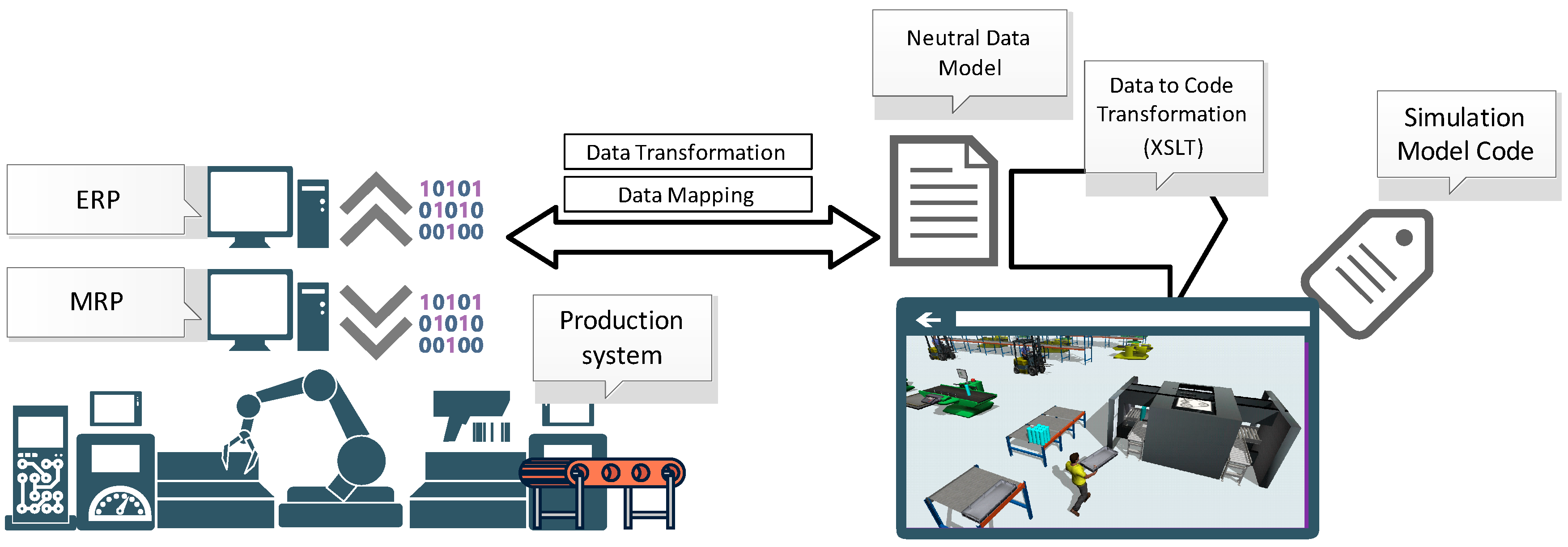



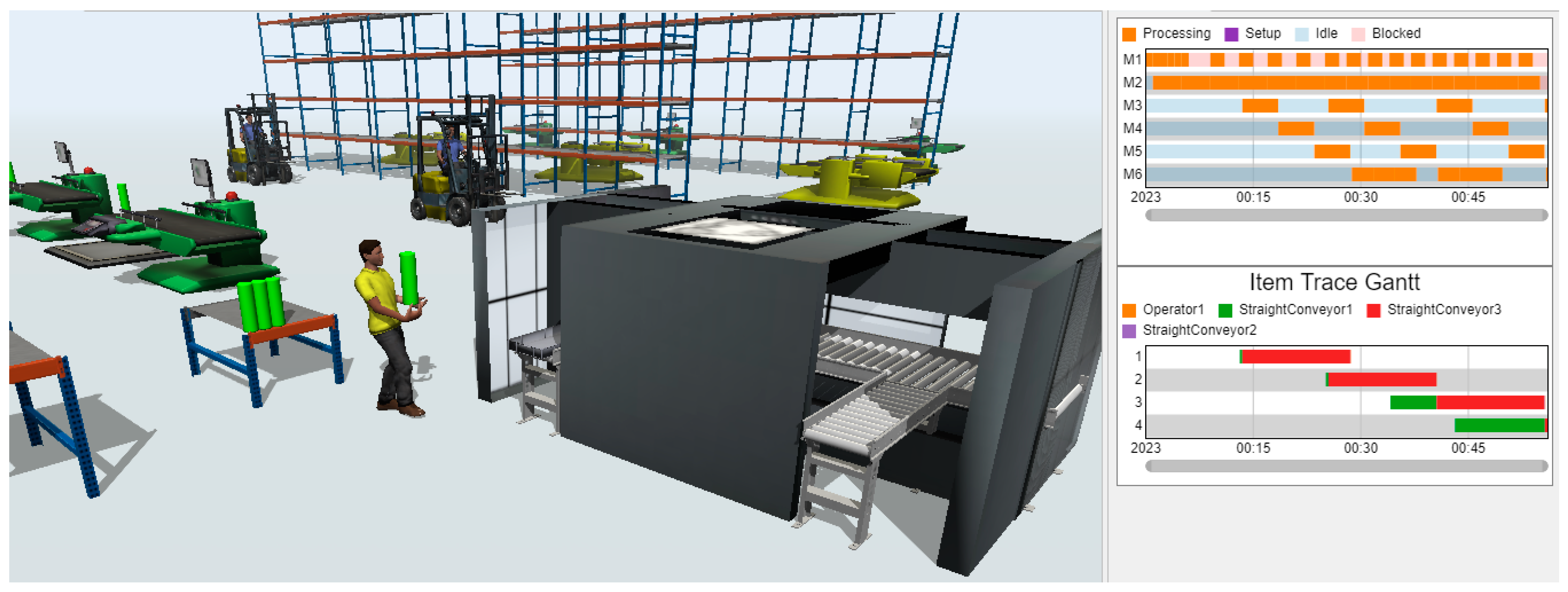

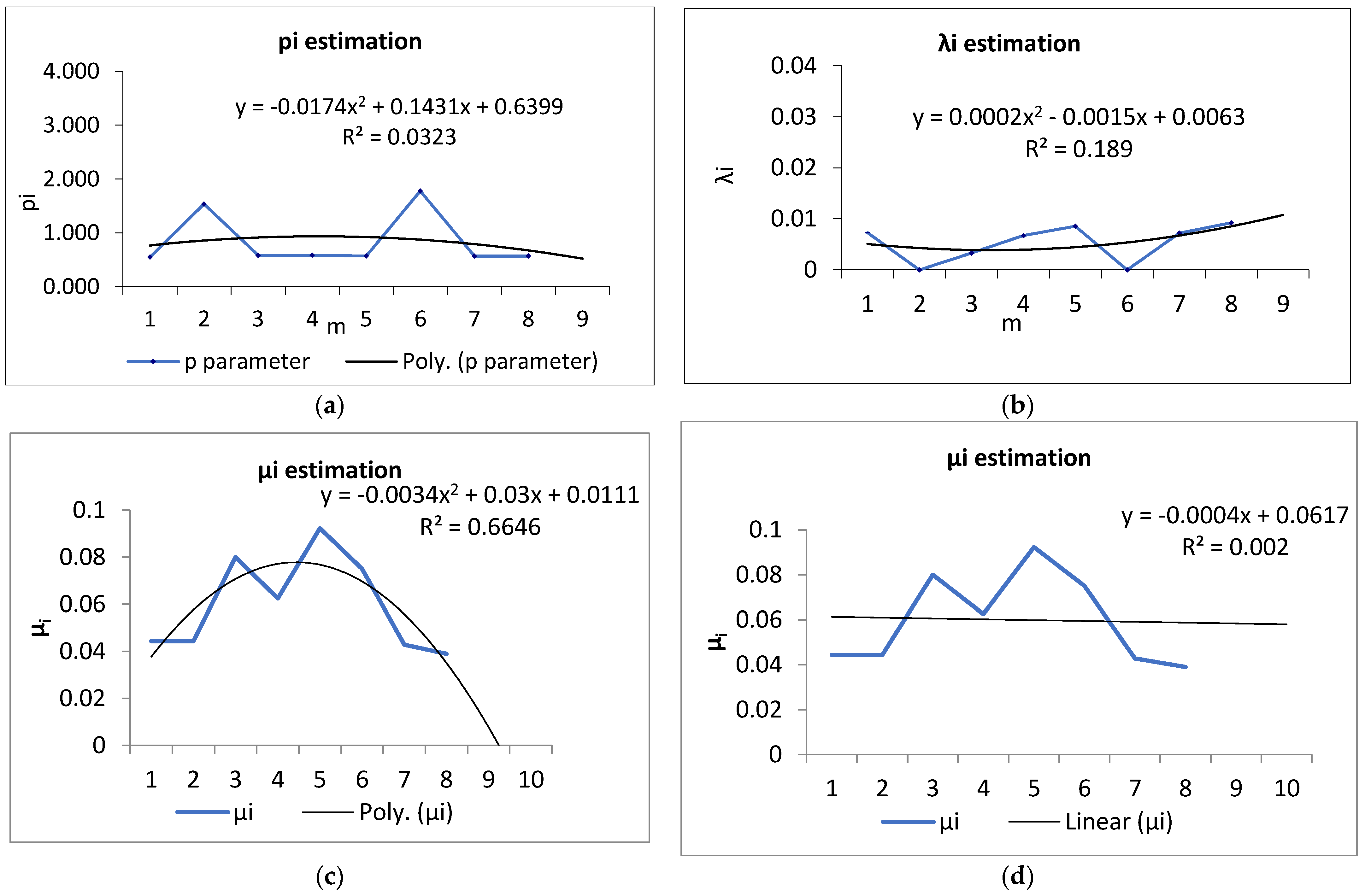
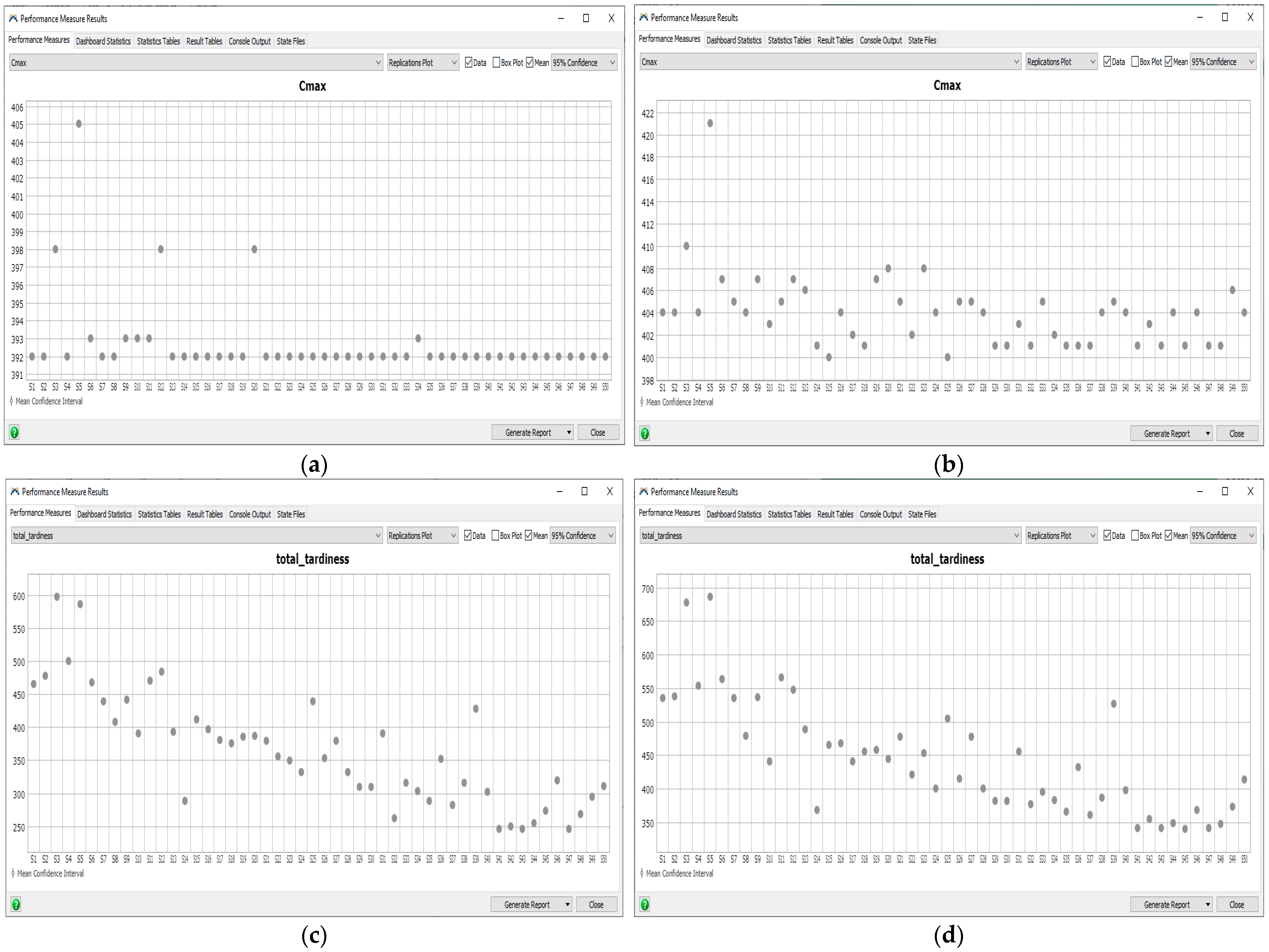
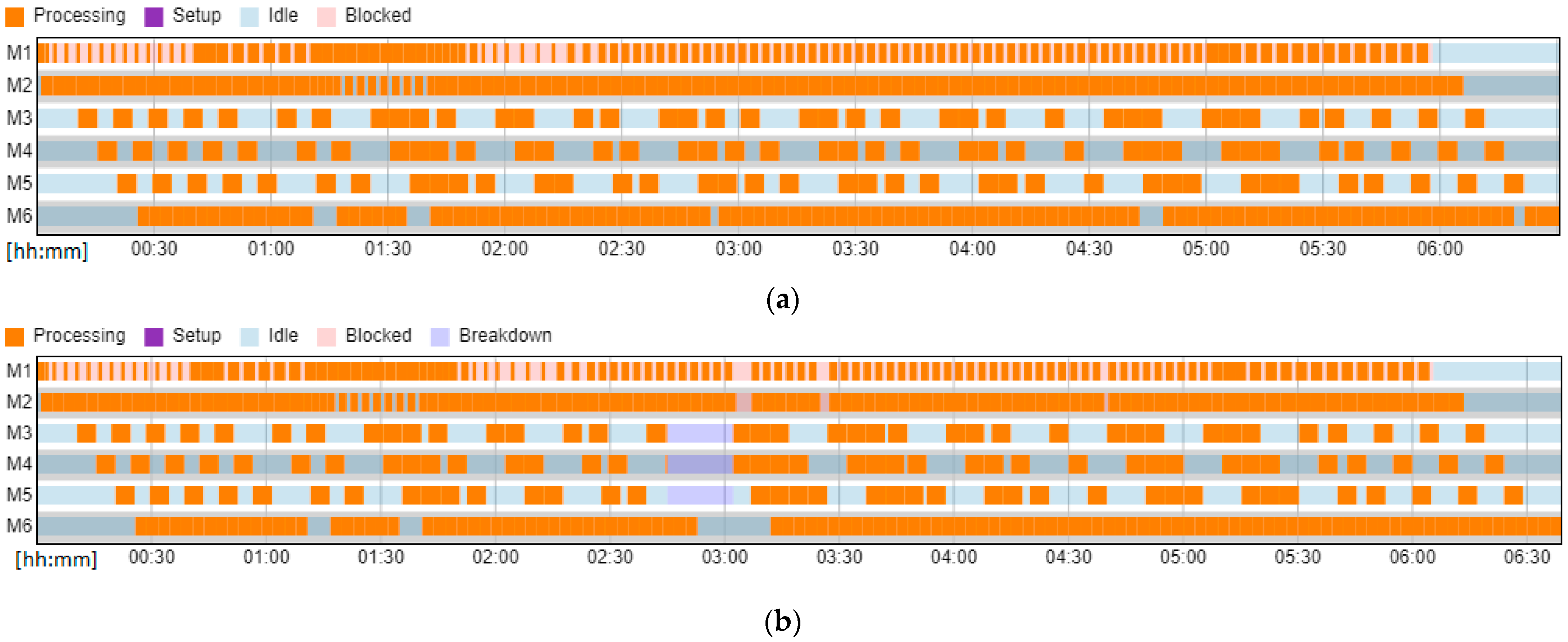

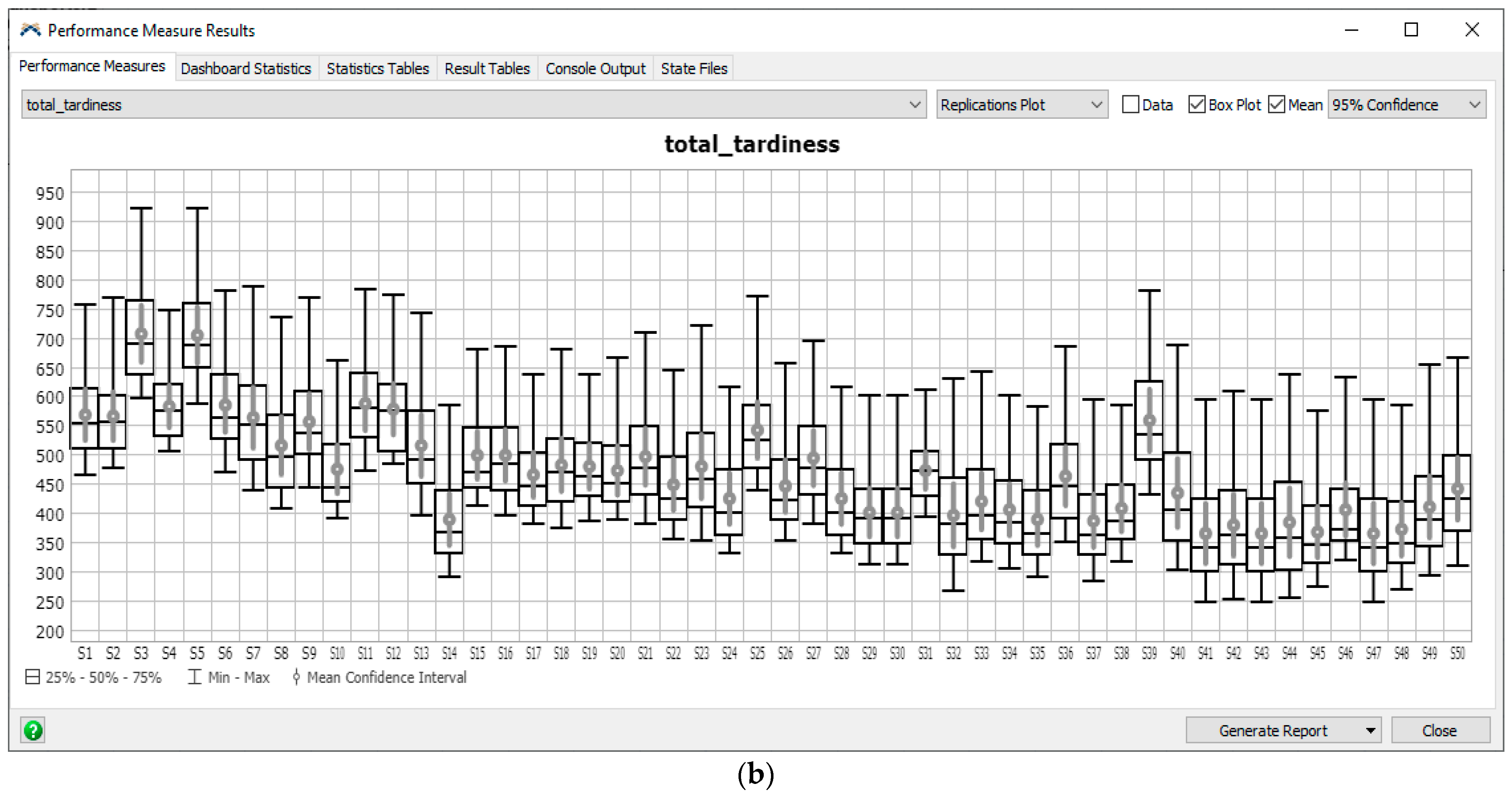
| No. Order | Problem | Idle Time | Failure Mode | Date | Failure Time | Maintenance Activities |
|---|---|---|---|---|---|---|
| 6….7 | locked tool #2 | 30 | shavings in the tool feeder | 01.03 | 6:20 a.m. | cleaning the magazine |
| 6…7 | filter filling level | 20 | the mat has been removed from the roll | 15.03 | 9:15 a.m. | the mat pulled into the rollers was pulled out |
| 6…2 | Tool changer failure | 20 | dirty sensor with shavings | 20.03 | 11:00 a.m. | cleaning the tool magazine |
| 6…9 | problem starting the machine | 25 | no air | 28.03 | 6:30 a.m. | unlocking the air valve, starting the machine, testing |
| 6…3 | camera problem | 20 | changing the position of the parts relative to the positions set in the camera | 19.04 | 7:30 a.m. | correction of the tool search area in the camera program |
| … | … | … |
Disclaimer/Publisher’s Note: The statements, opinions and data contained in all publications are solely those of the individual author(s) and contributor(s) and not of MDPI and/or the editor(s). MDPI and/or the editor(s) disclaim responsibility for any injury to people or property resulting from any ideas, methods, instructions or products referred to in the content. |
© 2023 by the authors. Licensee MDPI, Basel, Switzerland. This article is an open access article distributed under the terms and conditions of the Creative Commons Attribution (CC BY) license (https://creativecommons.org/licenses/by/4.0/).
Share and Cite
Krenczyk, D.; Paprocka, I. Integration of Discrete Simulation, Prediction, and Optimization Methods for a Production Line Digital Twin Design. Materials 2023, 16, 2339. https://doi.org/10.3390/ma16062339
Krenczyk D, Paprocka I. Integration of Discrete Simulation, Prediction, and Optimization Methods for a Production Line Digital Twin Design. Materials. 2023; 16(6):2339. https://doi.org/10.3390/ma16062339
Chicago/Turabian StyleKrenczyk, Damian, and Iwona Paprocka. 2023. "Integration of Discrete Simulation, Prediction, and Optimization Methods for a Production Line Digital Twin Design" Materials 16, no. 6: 2339. https://doi.org/10.3390/ma16062339
APA StyleKrenczyk, D., & Paprocka, I. (2023). Integration of Discrete Simulation, Prediction, and Optimization Methods for a Production Line Digital Twin Design. Materials, 16(6), 2339. https://doi.org/10.3390/ma16062339








